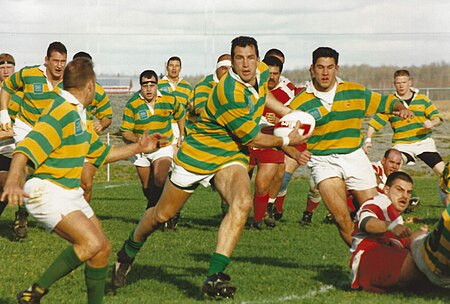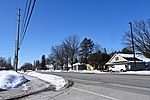Twin Elm Rugby Park

Twin Elm Rugby Park is a sports venue in South Nepean, Ottawa, Ontario, Canada. With five rugby fields and 12 changing rooms, two lounges, a bar and spectator seating for hundreds of people it can accommodate several concurrent matches and serves as the home of several local clubs. The facility is fully air conditioned with kitchen facilities. The Eastern Ontario Selects play their home games at the venue, and also hosts a number of national and international games. In addition to rugby, the park is also home to other sports such as soccer, lacrosse, ultimate Frisbee and volleyball. HistoryTwin Elm Rugby Park was founded by a dedicated group of rugby enthusiasts on June 25th, 1973. The park is jointly owned by the Bytown Blues, Ottawa Beavers & Banshees, Ottawa Ospreys, and the Ottawa Irish Rugby Club. Under the management of a volunteer Board of Directors, Twin Elm has grown over the last half century to hold a special place in Canada’s rugby history. The park has hosted provincial and national championships at the high school, junior and senior levels, as well as numerous international matches, including Canada’s epic 18-16 victory over France in 1994, and the Canadian women’s first ever home soil victory over the U.S.A. in 2001. With the explosive growth of Rugby 7's Twin Elm Rugby Park was fortunate to have been chosen to host the NACRA 7's championship in 2012. The park has also showcased the Canadian German Shepherd championship, Gaelic Athletic competitions, lacrosse, and touch football to list a few. In November 1996 the fabled front pitch became forever remembered as the site of World Rugby Hall of Fame's Al Charron's last club game on Canadian soil as he led his Ottawa Irish Rugby Club to the Ontario Rugby Union's McCormick Cup championship in a dramatic 29-17 victory over the York Yeomen. The victory secured an epic second Triple Crown complementing earlier season championships in the Rugby Ontario Magnificent 7's and the Senior League title.Dozens of internationals have developed their skills on Twin Elms five pitches, and have gone on to wear the maple leaf with pride at Rugby World Cup’s going back 30 years, most recently at the 2021 Women’s Rugby World Cup in New Zealand. Twin Elm also holds the unique distinction of being the only rugby park in the world to have produced the captains of both the women’s and men’s national teams in consecutive Rugby World Cups. This unprecedented accomplishment occurred when Sherri Sparling captained Canada at the 2002 Women’s Rugby World Cup in Spain, and Al Charron followed by leading the Canadian men’s squad into Australia in 2003.In the spring of 2023 Twin Elm continued its proud tradition of excellence in helping to develop elite players as the Ontario Senior women played two games against their Quebec counterparts, and the Rugby Canada Youth Commonwealth Games 7’s held trial matches. Twin Elm Rugby Park's status as the premier rugby facilities in Eastern Canada was solidified in July 2023 when the Austalian Wallaroos Senior women's national rugby team made Twin Elm Rugby Park their training venue of choice while visiting Ottawa, Canada for two weeks as part of the women's rugby 2023 Pacific Four Series. During this same period Twin Elm Rugby Park hosted women's international matches with a July 4th battle that saw USA U20 take on Wales. Wales was featured in a second international the following week as they took on Canada U20 on July 13th in a live broadcast that was streamed around the globe. A U18 Canada East training camp began the search for the next generation of great Canadian athletes. International Rugby Competitions Other Major Competitions
Excerpt from the Wikipedia article Twin Elm Rugby Park (License: CC BY-SA 3.0, Authors, Images).Twin Elm Rugby Park
Twin Elm Road, Ottawa Nepean (Rideau-Jock)
Geographical coordinates (GPS) Address External links Nearby Places Show on map
Geographical coordinates (GPS)
| Latitude | Longitude |
|---|---|
| N 45.2037 ° | E -75.795386 ° |
Address
Twin Elm Rugby Park
Twin Elm Road 4075
K0A 2Z0 Ottawa, Nepean (Rideau-Jock)
Ontario, Canada
Open on Google Maps




